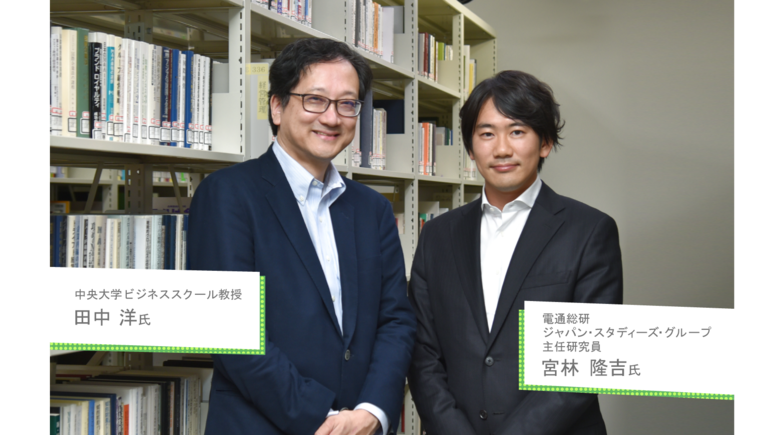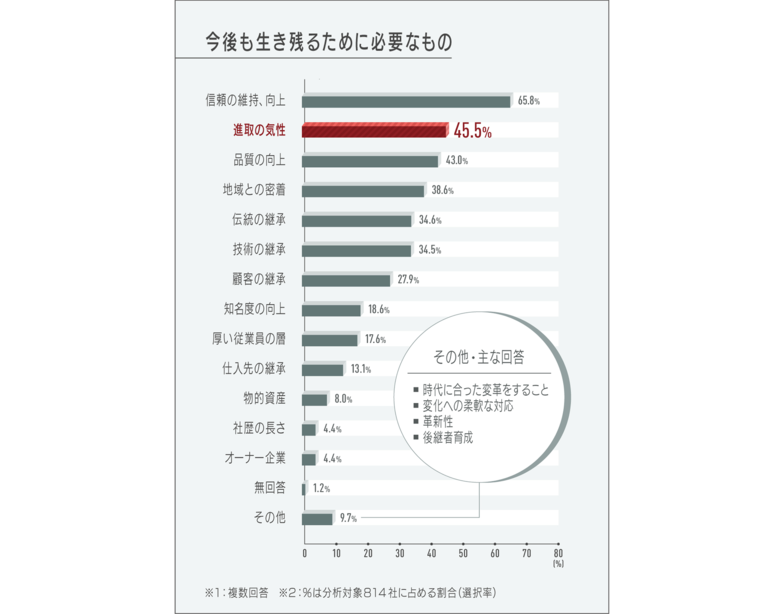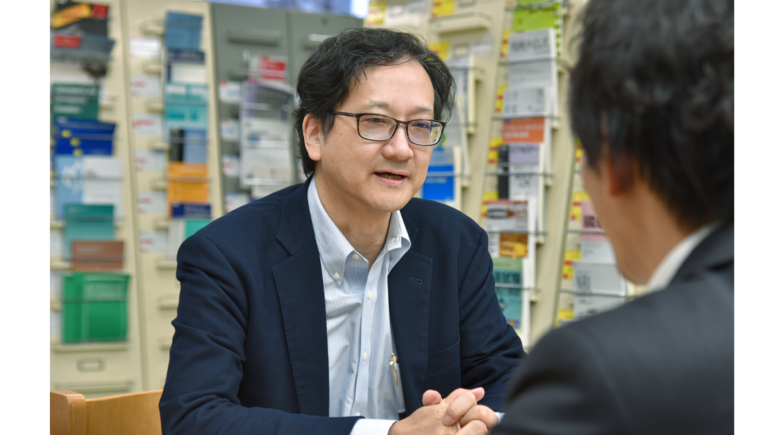In recent years, Japan has seen growing calls for developing global talent and organizational reform amid the globalization of business environments. However, discussions often focus on areas where Japan falls short compared to the West—such as Japanese people's lack of logical thinking skills, weak leadership among executives, and organizational homogeneity. This column aims to shine a light on Japan's inherent hidden strengths and appeal, exploring them through dialogue. Our first guest is Professor Hiroshi Tanaka of Chuo University Business School, a leading authority in brand marketing research. Takayoshi Miyabayashi, Senior Researcher at DENTSU SOKEN INC. Japan Studies Group, conducted the interview. This is the second part.
Longevity is proof of continuous change
Miyabayashi: There's an intriguing survey result from Teikoku Databank regarding long-lived companies. First, Japan has over 26,000 long-established companies that have been in business for over 100 years. This represents an unparalleled corporate environment globally. Furthermore, a questionnaire survey of approximately 800 of these long-established companies revealed that about 80% possess family or company precepts. When asked to express "what should be prioritized as a long-established company in a single kanji character," the top response was "信" (trust/faith), followed by "誠" (sincerity) in second place, and "継" (continuity) in third. These results suggest an environment fostering values rooted in a long-term perspective—in a sense, distinctly Japanese—such as coexistence with the community, connections with employees, and prioritizing business continuity. This makes direct comparison with Western companies difficult.
Tanaka: I'm not sure if only long-lived companies can be called Japanese-style companies, but they clearly differ from Silicon Valley-style companies and can be considered an alternative.
Miyabayashi: Could there be some hidden strength unique to Japanese companies at play here?
Tanaka: Dutch management thinker Arie de Hoog, author of "Living Companies," analyzed common traits among long-lived firms. Many tend to avoid excessive diversification, remain committed to their core family business, are solid and conservative in finance, yet have meticulously adapted to environmental changes. This area certainly warrants further research.
Miyabayashi: That's fascinating. At first glance, long-lived companies might seem unchanging, conservative, and slow-moving. But actually, we could view them as "companies that have changed more than anyone else." Indeed, according to a survey by Teikoku Databank, when long-established companies were asked what was necessary for their continued survival, the top three responses were "maintaining and enhancing trust," "a pioneering spirit," and "improving quality." This "pioneering spirit" reflects a determination to "keep changing without fear of change," even as an established firm, and I believe this is what supports their longevity exceeding 100 years.
Tanaka: As mentioned in the book I recently reviewed (Nikkei Morning Edition, October 8, 2015), "How Singularity University Teaches You to Leap Forward," companies like Google, based on IT and information, have achieved exponential growth, embodying the Silicon Valley model. Conversely, companies established before 1700 represent a business model that persists tenaciously, almost crawling along the ground. Is it better to be a company that grows exponentially, or one that endures for centuries? Whether growth is the overriding imperative or continuity is the goal likely depends on the values of the management. Companies like Google or Facebook probably aren't necessarily managed with the goal of surviving for 300 or 400 years. It's fair to say that Japanese long-lived companies represent a different model, starting from their very purpose of management.
Global Strategy Leveraging Japanese Corporate Strengths
Miyabayashi: Are there any distinctive examples demonstrating the innovative capabilities of Japanese companies that hold up globally?
Tanaka: One example is the globalization of Japanese companies through M&A. For instance, the company that acquired the Thermos Group was formerly known as Nippon Sanso, or Nippon Sanso Corporation. Thermos is a household goods manufacturer founded in Germany, centered around glass vacuum bottles, and is a global brand with networks in the UK, Canada, and the US. On the other hand, Nippon Sanso had technology cultivated in its industrial gas business. This led to the successive creation of hit products like titanium vacuum bottles, vacuum cookers, and more recently, sports jugs and portable mugs. The Thermos case demonstrates how linking a Japanese company's strengths, or expertise, with a global brand can achieve what others cannot. Similarly, Japan's Ace acquired the American company Zero Halliburton in 2006, combining Ace's technological capabilities with Zero's brand power to offer compelling products worldwide.
Miyabayashi: In a sense, it's an ideal example of successful M&A. Building a global brand from scratch in the B2C market is an extremely difficult path. Could M&A, aimed at shortening development time and acquiring talent, be a significant weapon?
Tanaka: It's true that very few Japanese companies hold strong brands in the B2C market. Acquiring overseas brands to catch up is certainly a viable strategy, but the key to achieving a leap forward lies in selecting a brand that aligns well with the company's own technology. Whether in marketing or branding, the crucial factor is identifying the right marketplace. By marketplace, I mean not just focusing on competitive advantage, but effectively finding a market that aligns with your company's capabilities, customer needs, and the times, and concentrating your efforts there.
Miyabayashi: So, only by knowing oneself and knowing others can one see the path to victory. Perhaps the true meaning of going global lies in rediscovering one's own strengths.
Japanese Local Companies Competing on the Global Stage
Miyabayashi: Next, I'd like to hear about Japanese companies that are performing strongly against global competitors in the Japanese market and their characteristics.
Tanaka: Take Milbon, a company specializing in salon cosmetics. While listed on the Tokyo Stock Exchange's First Section, it's not necessarily a household name. Yet, its salon hair care products hold the top domestic market share, outperforming renowned foreign companies. It also competes strongly against global brands overseas and has sustained growth for nearly two decades.
Miyabayashi: What exactly makes them so successful?
Tanaka: Since the 1980s, Milbon has implemented a system called "Customer Representative System" or "TAC" (short for Target Authority Customer). This mechanism involves understanding the specific needs of each salon customer through the hairstylist and then developing new products based on those needs. For example, suppose there's a popular stylist in a small town whose cuts are known for maintaining that "fluffy" feel longer. Milbon would study how that stylist meets individual needs—learning everything from gel application techniques to blow-drying methods and philosophies—and apply those insights to product development. Then, once a new product is developed, they repeatedly communicate to stylists nationwide, "Doing it this way will delight your clients."
Miyabayashi: That's fascinating. Is this concept similar to what today's marketing calls "lead users"?
Tanaka: "Lead users" is a concept explicitly defined by Professor Eric von Hippel at MIT Sloan School of Management. It refers to people with far more advanced needs than the general user. For example, when developing car brakes, if you think about who possesses the advanced technology to stop a car traveling at high speeds, you might think of a racing car driver. Then, if you look for someone with even more intense needs, you arrive at aircraft developers.
In other words, if you want to innovate car brakes, you should consult aircraft developers researching brakes. Thus, lead users often refer to professionals with more urgent needs. However, the lead user approach is not universally applicable; lead users don't exist in every category. Asking who the lead user for ice cream is would be a bit of a stretch.
In contrast, the "customer representative system" targets a small group of customers who collectively embody user needs and can articulate them. While lead users are professionals or experts, the users addressed by the customer representative system are almost complete novices in product development. Yet, unlike ordinary customers, they can articulate their own needs and concerns and are willing to cooperate in improving products or services.
Miyabayashi: How did Milbon arrive at the concept of the customer representative system?
Tanaka: Interestingly, Mirbon's founding president, Ichiro Konoike, has stated that a lecture by Kihachiro Onitsuka, founder of Onitsuka Shoji (the predecessor of today's ASICS), provided the hint for the customer representative system. Athletes wearing Onitsuka shoes won a total of 46 medals at the 1964 Tokyo Olympics. Onitsuka's strategy, which he called the "Summit Strategy," focused on targeting individuals playing leading roles in sports. Mr. Konoike reportedly drew inspiration from hearing how Mr. Onitsuka improved his shoes by soliciting feedback from athletes and coaches while traveling nationwide to sell them. Mr. Onitsuka was already putting this concept into practice in the 1950s.
Miyabayashi: So, the creator of Onitsuka Tiger was the first to practice this innovative marketing approach.
Tanaka: While this remains speculation, I imagine the two ideas conceived by Nike founder Phil Knight—importing shoes produced by Japan's Onitsuka Tiger for global sales, and sponsoring top athletes in each sport in exchange for them wearing shoes bearing their logo—were also significantly influenced by Onitsuka. Japanese companies with unexpected marketing approaches, like Onitsuka's "Summit Strategy" or Milbon's "Customer Representative System," can compete confidently on the global stage. While the systematization of marketing theory progressed primarily in the US, limiting their exposure, some concepts were actually pioneered in Japan.
Miyabayashi: Hearing your perspective, I feel it's crucial not to simply compare the strengths of Japanese and foreign companies, but to leverage the strengths of Japanese firms while incorporating external strengths they lack. Combining and editing these elements allows them to become truly unique entities. Furthermore, Japan still seems to hold many assets worth introducing to the world, such as strategic concepts yet to be discovered by academia.
Tanaka: Now is precisely the time to make efforts to unearth these assets and visualize their value.
Miyabayashi: Thank you very much for today. (End)









